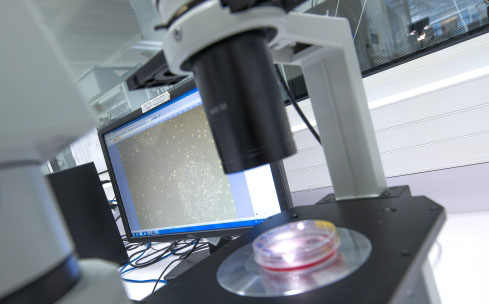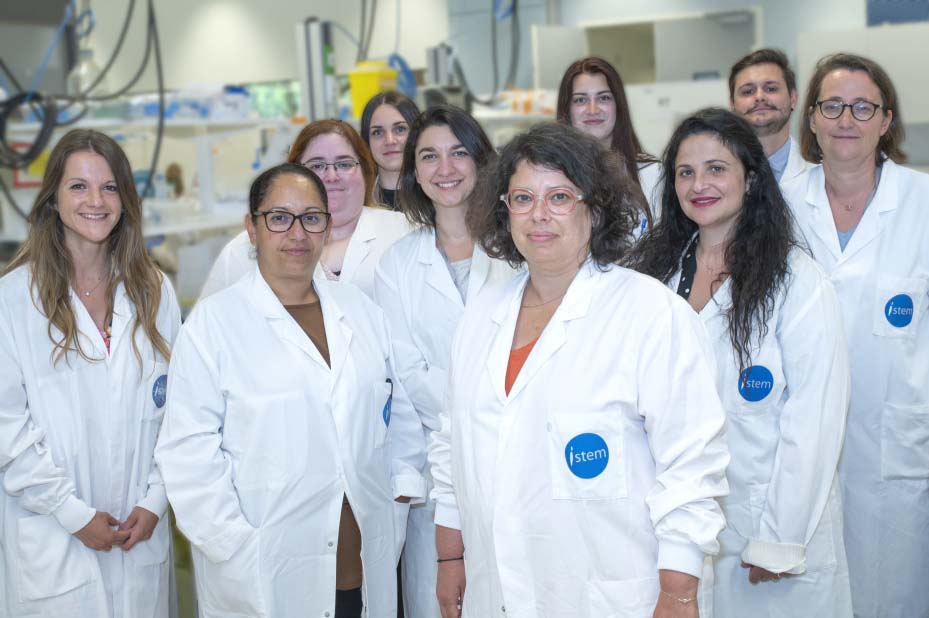Genodermatoses
Genodermatoses are genetically transmitted skin disorders. The team’s objective is to understand the potential offered by human pluripotent stem cells (keratinocytes, melanocytes, fibroblasts) to develop therapeutic applications for Genodermatoses.
Using protocols for differentiating human pluripotent stem cells of embryonic origin (hES ) or induced pluripotency (hiPS) into specialized skin cells, the team is developing two main lines of research:
Pathological modeling
The objective of this axis is to generate modelsin vitro of pathologies of genetic origin, by differentiating iPS carrying a mutation in a gene coding for a particular protein involved in a disease. The team works on several pathologies, such as Epidermolysis Bullosa or vitiligo. These models are then characterized phenotypically and functionally to identify a pathological phenotype. They can then be used to understand the mechanisms of the pathology, or as a screening model for pharmaceutical molecules.
Cell therapy :
Here, the objective is to develop cellular therapies for skin repair. The team is particularly focused on the development of a product composed of keratinocytes derived from pluripotent stem cells to treat chronic leg ulcers, particularly in the context of sickle cell ulcers (PACE program). In a second phase, this work paved the way for the complexification of the product by including other iPS-derived cell types, such as fibroblasts, in order to improve the healing efficiency (Genesis Program).
In parallel, in order to improve yields and control production costs of cell therapy products, a program is being developed to establish a continuous, non-destructive and standardized quality control of the differentiation of these cells using holographic microscopy and deep learning. (Stellar Program).
Team members
Christine BALDESCHI
Team Leader & University Professor (UEVE)
Christine joined I-Stem in 2007 as a professor at the University of Evry. At I-Stem, she is developing cell therapy and pathological modeling approaches for the treatment of skin disorders associated with genetic diseases, using pluripotent stem cell derivatives.
Nathalie Holic
Assistant Professor (UEVE)
Nathalie is a lecturer at the University of Evry and joined I-Stem in 2017. Thanks to her expertise in genome engineering, she is developing innovative molecular tools to create cellular models to characterize epidermolysis bullosa simplex.
Manoubia SAIDANI
Engineer (CECS)
Manoubia joined the Genodermatoses team at I-Stem in 2008, and is involved in the development of skin cell models derived from pluripotent stem cells. These 2D and 3D models enable her to model skin pathologies such as epidermolysis bullosa and vitiligo.
Sophie DOMINGUES
Engineer (CECS)
Sophie has been working at I-Stem since 2011, as part of the Genodermatoses team’s PACE cell therapy project. This project aims to develop reconstructed skin in the laboratory that can be used as a biological dressing to treat skin ulcers linked to a genetic disease.
Annabelle DARLE
Engineer (CECS)
Annabelle joined the Genodermatoses team in 2015. She works on the PACE and STELLAR cell therapy projects. She is also interested in the mechanisms of stem cell differentiation into keratinocytes using molecular biology techniques.
Jennifer ALLOUCHE
Post-Doc (UEVE)
After a thesis completed at I-Stem in 2015 on the potential of pluripotent stem cells to model pigmentary diseases and a postdoctorate at Harvard on melanogenesis, Jennifer returned to I-Stem in 2020. Her research focuses on the development of new therapeutic strategies for vitiligo. In the Genodermatosis team, she has been responsible for pathological modeling of pigment disorders since 2023.
Tatiana SAOUDI
Engineer (CECS)
A member of the team since January 2021, Tatiana works on the Genesis project, in particular on the differentiation of human induced pluripotent stem cells into fibroblasts and their associated quality controls.
Céline BOURE
Engineer (CECS)
A member of the team since February 2021, Céline works on the Genesis project. She is contributing to the development of cell differentiation processes and associated quality controls for cells and the final product, for the manufacture of artificial skin.
Marion CHALOT
Engineer (CECS)
Joining the team in 2022 after completing her PhD at the CEA, Marion is an associate researcher and head of the Genesis project in the Genodermatoses team. She is working on the creation of artificial skin for grafting using tissue engineering.
Sabrina MARTINEAU
PhD Student
Having joined the Genodermatose team in 2019 as a Master 1 intern, Sabrina went on to complete her Master 2 internship and began a PhD in October 2020. Her thesis project involves studying the molecular mechanisms of Epidermolysis Bullosa Simple using a keratinocyte model derived from human pluripotent stem cells.
Bénédicte DE MUYLDER
Research technician
Assistant Inserm Engineer, joining I-Stem in September 2023. Bénédicte participates in the various cell therapy and modeling projects of the Genodermatoses team.
Patricia Senet
Clinical Dermatology Doctor
Patricia is a dermatologist at Tenon Hospital (Assistance Publique – Hôpitaux de Paris). She joined I-Stem in 2023 on a part-time clinical research position at APHP for 2 years. She will be in charge of developing the clinical phases of the PACE project (chronic leg wounds of genetic origin).
Collaborations
Epidermolyse bulleuse Program
Stellar Program (BPI funding)
Stellar Program (BPI funding)
PACE Program
PACE Program
GENESIS Consortium
GENESIS Consortium
GENESIS Consortium
GENESIS Consortium
Vitiligo Program
Publications
Generation of heterozygous and homozygous NF1 lines from human-induced pluripotent stem cells using CRISPR/Cas9 to investigate bone defects associated with neurofibromatosis type 1.
01 January 2024
Frontiers in cell and developmental biology
Generating Functional and Highly Proliferative Melanocytes Derived from Human Pluripotent Stem Cells: A Promising Tool for Biotherapeutic Approaches to Treat Skin Pigmentation Disorders.
29 March 2023
International journal of molecular sciences
Human-Induced Pluripotent Stem Cell‒Derived Keratinocytes, a Useful Model to Identify and Explore the Pathological Phenotype of Epidermolysis Bullosa Simplex.
01 October 2022
The Journal of investigative dermatology

